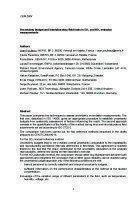Air Monitoring
Uncertainty budget and interlaboratory field tests in SO2 and NOx emission measurements
Oct 03 2014
Author: Jean Poulleau, Cécile Raventos, Frans Blank, Lukas Emmenegger, Richard Gould, Hakan Kassman, Emile Pilage, Serge Reynaud, Joern Rokkjaer, Michael Waeber on behalf of CEM
Abstract
This paper compares two techniques to assess uncertainty on emission measurements. The first one, described in ISO 14956, gives an appropriate procedure to establish uncertainty budgets from systematic assessment of factors influencing the result. The second approach consists in the quantification of the fidelity of the method during inter and intra-laboratory field experiments set out according to ISO 5725-2.
The comparison has been carried out for two reference methods described in the drafts prepared by CEN/TC264/WG16.
For the SO2 manual reference method
Uncertainty budgets lead to very realistic overall uncertainty comparable to the repeatability and reproducibility confidence intervals determined in field tests. This agreement is reached thanks to the fact that the major contribution to the uncertainty calculation is the analysis reproducibility, determined during an inter-laboratory exercise.
For the NOx automatic method, the comparison shows rather big discrepancies between both approaches and enlightens the conclusion that a rather good reliability can be reached using the uncertainty budget approach only if the following conditions are met:
- trained personnel to correctly establish and interpret uncertainty budgets,
- sufficient information on the performance characteristics of the method at the studied concentration,
knowledge of the variation range of influent parameters in the field, such as temperature, humidity, voltage, etc.
1. Introduction
Many European laboratories are nowadays accredited to the quality assurance standard for the competence of testing and calibration laboratories, ISO/IEC EN 17025 [15]. Among other things, this Standards requires the laboratory to identify all uncertainty components of the implemented method and gives a reasonable estimation of the overall uncertainty attached to the measurement results. For the validation of methods, mainly main techniques are proposed:
- A systematic assessment of factors influencing the result and their associated standard uncertainty on the basis of theoretical principles and practical experience.
- Interlaboratory (in-field) comparisons.
Furthermore, a thorough validation of the method will include field tests to verify that its performance data and calculated measurement uncertainty comply with results obtained under field conditions. Appropriate procedures for air quality measurements - whose output is a defined time average - are described in EN ISO 14956. These methods are well suited for the evaluation of emission measurement techniques. Finally, the ISO 5725-2 provides guidelines and tools to plan such intra or inter-laboratory campaigns [14].
Today, most CEN standards identify the major sources of uncertainty contributing to the measurand and often provide criteria for acceptance related to the main performance characteristics, as well as to the overall uncertainty. Recent standards for ambient air measurements and their concepts with respect to uncertainty have been discussed by E. Sneek [11]. A review of the recommendations given in EN 13005, the ISO Guide to the Uncertainty of Measurement (GUM)(reference?), with special focus on ambient air and stack emission monitoring has been published by R. Beier and R. Kordecki [1]. This paper will focus on emission measurements and give examples of uncertainty budgets determined according to the GUM. The results will then be compared to performance characteristics obtained in inter and intra-laboratory field experiments.
The examples are taken from the work carried out by CEN/TC264/WG16 which is mandated to develop five standards for the measurement of O2, CO, NOx, H2O and SO2, as well as a technical report describing how to evaluate equivalent methods [6, 7, 8, 9, 10]. This paper discusses the manual reference method for SO2 and the automatic reference method for NOx. The extensive international laboratory and field testing provide an excellent opportunity to compare the overall uncertainty calculated through an uncertainty budget (GUM) with the field approach yielding uncertainties for (intra-laboratory) repeatability and (inter-laboratory) reproducibility.
Digital Edition
AET 28.2 April/May 2024
May 2024
Business News - Teledyne Marine expands with the acquisition of Valeport - Signal partners with gas analysis experts in Korea Air Monitoring - Continuous Fine Particulate Emission Monitor...
View all digital editions
Events
Jul 30 2024 Jakarta, Indonesia
China Energy Summit & Exhibition
Jul 31 2024 Beijing, China
2024 Beijing International Coal & Mining Exhibition
Aug 07 2024 Beijing, China
IWA World Water Congress & Exhibition
Aug 11 2024 Toronto, Canada
Aug 25 2024 Stockholm, Sweden and online






.jpg)








